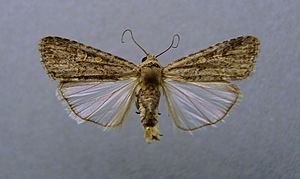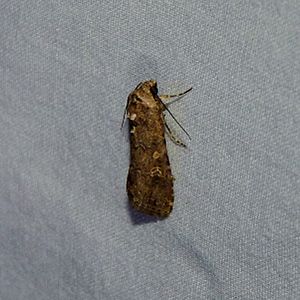Beet armyworm facts for kids
Quick facts for kids Beet armyworm |
|
|---|---|
 |
|
 |
|
| Scientific classification | |
| Synonyms | |
|
The beet armyworm (Spodoptera exigua) is a well-known agricultural insect pest. It is also called the small mottled willow moth or the asparagus fern caterpillar. This insect originally came from Asia. Now, you can find it almost anywhere its favorite plants grow around the world. The hungry larvae (caterpillars) cause most of the damage. In places like the British Isles, where it doesn't usually breed, the adult moth is known as the small mottled willow moth.
Contents
Discovery of the Beet Armyworm
Scientists believe the beet armyworm first appeared in Southeast Asian countries. It was first found in North America around 1876, in Oregon. By 1924, it had spread to Florida.
What Does the Beet Armyworm Look Like?
The adult beet armyworm is a plain brown or grey moth. Its wingspan is about 26 to 32 millimeters (about 1 to 1.25 inches). The front wings are greyish-yellow with small black spots. The back wings are mostly white with dark brown veins.
The larvae, or caterpillars, are greenish-brown. They are soft and look a bit swollen. They have dark stripes running along their bodies.
How Beet Armyworms Damage Plants
The larvae of the beet armyworm eat the leaves and fruits of plants. They can completely strip small plants of their leaves. Younger larvae eat only the soft parts of leaves, leaving behind thin skin and veins.
Older, larger larvae make holes through thick parts of plants. For example, they might burrow right into a head of lettuce. This makes the plant impossible to sell. These larvae also attack new buds and young growth. This stops flowers from opening, new leaves from growing, and vegetables from forming. As the smaller larvae move, they leave behind thin strands of silk. This makes the leaves look like they are covered in a silvery film.
Where Beet Armyworms Live and What They Eat
The beet armyworm can eat many different kinds of plants. These include asparagus, beans, peas, beets, celery, cabbage family plants, lettuce, potato, tomato, cotton, cereals, oilseed plants, tobacco, and cannabis. They also eat many types of flowers and weeds.
These insects do not like cold weather. They can survive the winter in warm places like Florida and Hawaii. But in colder areas, they die off when winter comes. When the weather gets warm again and new crops start to grow, adult moths fly in from warmer places to lay eggs.
Controlling Beet Armyworms
Farmers use different methods to control beet armyworms.
Natural Control Methods
- Traps and Hand Picking: Farmers use special traps with scents (pheromones) to catch adult moths. They also pick adult moths and caterpillars off plants by hand.
- Helpful Insects: Some insects are natural enemies of the beet armyworm.
- Parasitoids: These insects, like Chelonus insularis and Cotesia marginiventris, lay their eggs on the caterpillars. When the eggs hatch, the larvae eat the caterpillar from the inside.
- Predators: Other insects, such as Orius sp. and Geocoris sp., hunt and eat the caterpillars.
- Fire Ants: Introducing Solenopsis invicta (fire ants) into fields can help get rid of the pupal stage of the armyworm.
Chemical Control Methods
- Neem Products: Larvae are sensitive to products made from the neem tree.
- Oils: Petroleum oil can kill eggs. Applying cottonseed oil to leaves can kill both eggs and young larvae.
See also
 In Spanish: Gardama para niños
In Spanish: Gardama para niños



